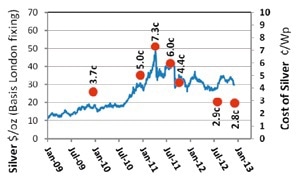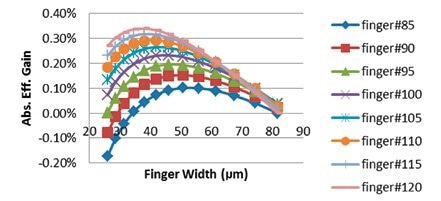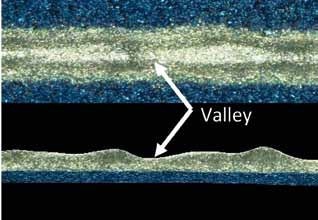Reducing the cost of solar energy continues to be an important aspect in the PV industry. The fundamental goal of solar energy is to be economically viable with present sources of electricity. In the last few years, the cost of crystalline silicon solar cells and modules has reduced considerably; however the cost per Wp must go down even further to make it a more attractive option.
Cost per Wp
One way to reduce the cost per Wp is cut down the production cost, which relies on the cost of consumables. In order to reduce the cost of a consumable, either the amount used can be reduced or the purchase price can be lowered. Another way is to boost the amount of Wp created per solar cell - in other words, improve the cell efficiency (η).
In 2012, the cost of solar cells reduced considerably owing to reduction in the purchase price of aluminium and polysilicon metallization paste. Also, by enhancing the printability and conductivity of the silver metallization paste, the amount of silver required per cell was reduced to over 50% in three years. Despite increase in the silver price over the last three years, the cost per Wp of silver usage is lower than ever.
In recent years, silver metallization paste has considerably helped in increased efficiency. Such improved efficiency originates from a number of enhancements, such as:
- An increase in fill factor
- An increase in short-circuit current (Isc) owing to a decrease in metallized area
- An increase in open-circuit voltage (Voc ) owing to reduced phosphor concentration in the emitter
- An increase in fill factor (FF) due to reduced contact resistance (Rc) and finger-line resistance
Improvements in the screen-printable silver paste have made it possible to make all of these changes.
Properties of Silver
Silver is an expensive metal, but it exhibits the lowest resistance. It is also strong, reliable and is used as a conducting and contacting metal for crystalline solar cells. When assisted by glass frit, silver can grow silver crystallites on the silicon interface through easy and reliable processing. It also offers the reliability needed in silicon modules.
However, despite the higher price of silver, an actual cost reduction of 25% per Wp has been realized, as shown in the figure 1. This is attributed to a steep drop in silver usage and the associated increase in efficiency made possible by enhancements in the silver metallization paste.

Figure 1. Price of silver per troy ounce (–) from January 2009 to January 2013 vs. the cost of silver per Wp (•) for front-side metallization.
Improvements in Conventional Solar Cells
Some of the easiest methods to improve efficiency are to increase current by reducing the metallized surface; increase current and voltage by reducing the doping level of the emitter; and increase fill factor by reducing the contact and finger-line resistances.
The Effect of Enhanced Pastes
In order to demonstrate enhancements in contacting, two groups of solar cells were made on wafers having an average sheet resistance of 750/sq; one using the new SOL961QA paste and the other using an 'old' reference paste.
Table 1. Comparison of an ‘old’ reference paste and SOL9610A
| Paste |
Isc
[A] |
Voc
[mV] |
FF
[%] |
η
[%] |
Rs
[mΩ] |
Rsh
Ω |
Rc
Ω |
Line width
[μm] |
Paste usage
[g] |
| Reference |
8.726 |
626.4 |
77.20 |
17.34 |
3.3 |
190 |
0.304 |
70.8 |
0.110 |
| SOL9610A |
8.706 |
625.8 |
78.44 |
17.56 |
2.6 |
202 |
0.217 |
76.3 |
0.122 |
Rc has been decreased from 0.304 to 0.217Q by improving the contacting mechanism, Rc. This results in a lowering of the series resistance (R) by more than 20%. A slight lowering of Isc and Voc is offset by an increase in FF of 1.6% relative, resulting in increase in efficiency of 0.22% absolute. If the finger-line width is optimized, the enhancement could possibly be increased to a further 0.05% absolute. Additional increases in sheet resistance will increase the solar cell’s blue response owing to a reduction in recombination, thus resulting in a gain in both Isc and Voc.

Figure 2. Expected impact of line width (change in open area) and number of finger lines (changes in Remitter and Rc) on efficiency.
Sophisticated Screen Printing for Standard Cells
When thinner finger lines are utilized, the screen for screen printing becomes limiting in line uniformity and line height, as shown in figure 3. This limitation can be overcome by introducing a second print step for the front-side pattern. Two different process flows are now possible, such as dual print and double print, also known as ‘print on print’.

Figure 3. A ‘valley’ in a finger due to wire mesh, resulting in an increase in resistance
Dual and Double Prints
In dual print, the busbars are printed in a separate step, while the finger lines are deposited in a single print step. Through this process flow, optimized screens and pastes can be utilized for the two different steps so as to ensure a high aspect ratio for the finger lines and a low lay-down of paste for the busbars. Stencil screens can be also be utilized in one or both steps.
In case of double print, only the finger lines are deposited in a first print step. Then, a full pattern is deposited in a second print step, with the finger lines precisely on top of the first print. The busbars are printed only once, which results in finger lines having relatively few busbars and a high aspect ratio. In the second print, constrictions are repaired, as more paste is deposited in the valleys of the finger line. Specialized pastes may be used for the first and second prints.
At present, two-step print processes are being employed in large-scale production. With these process flows, higher efficiencies can be achieved and paste consumption can also be reduced.
n-type and Interdigitated-back-contact Solar Cells
In general, n-type wafers have higher lifetimes when compared to conventional p-type wafers. Different cell types based on n-type wafers are being produced. The interdigitated-back-contact (IBC) cells of Panasonic and Sunpower have the highest efficiencies, with each having reported efficiencies of more than 23%. However, the production procedures for these cells are totally different from those utilized in the traditional crystalline silicon PV industry.
Conclusion
Silver metallization pastes have demonstrated high conductivity, good chemical and physical stability, and excellent contacting behaviour. When compared to other technologies, the screen-printing process helps in maintaining high production yields.
Through research and development, the silver metallization pastes were improved to increase cell efficiency at a lower cost per Wp. In addition, the 50% reduction in paste usage played a critical part in reducing the cost per Wp. Therefore, with continued enhancement of silver metallization pastes, front-side metallization will maintain its readiness for lower costs per Wp and higher efficiencies in order to make solar energy more competitive in the coming years.
About Heraeus Photovoltaics
The Heraeus Photovoltaics Business Unit is an industry leading developer and manufacturer of metallization pastes for the photovoltaic industry.
Heraeus has been a manufacturer of thick film pastes for over 40 years. Since 2008, we have been an innovative supplier to the photovoltaics industry, working with c-Si cell manufacturers to improve their cells’ efficiency for both conventional and advanced cell designs.
Heraeus have developed silver metallization pastes that have been integrated into commercially available technologies such as MWT, Double Print, Dual Printing, Selective Emitter, Back Side Passivation and N-Type Cells.
Heraeus have also expanded our capabilities and developed lower temperature processing pastes for Thin Film and other c-Si technologies.
Heraeus' goal is to improve our customers’ cell efficiency and reduce their cell’s cost per watt through our innovative paste design technology.

This information has been sourced, reviewed and adapted from materials provided by Heraeus Photovoltaics.
For the original article, please visit Heraeus Photovoltaics' white papers and articles.